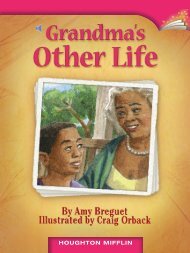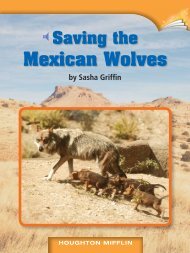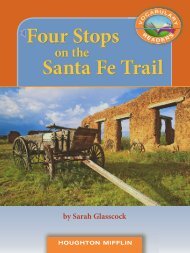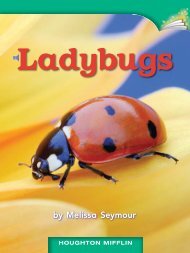You also want an ePaper? Increase the reach of your titles
YUMPU automatically turns print PDFs into web optimized ePapers that Google loves.
<strong>How</strong> <strong>Barbed</strong> <strong>Wire</strong><strong>Changed</strong> <strong>the</strong> <strong>West</strong>by Barbara M. SharpPHOTOGRAPHY CREDITS: Cover © Ralph A. Clevenger/CORBIS. Title page American Stock/Getty Images. 2 JeremyWoodhouse/Getty Images. 3 Geoff Brightling/DK Images. 5 © Tom Bean/CORBIS. 7 Jeremy Woodhouse/Getty Images.8 The Granger Collection, New York. 9 (l) (r) US Patent and Trademark Office, Patent No. 157124 and No. 167240.10 © Ralph A. Clevenger/CORBIS. 13 © Ralph A. Clevenger/CORBIS. 15 American Stock/Getty Images. 17 BrianHagiwara/Brand X Pictures.Copyright © by Houghton Mifflin Harcourt Publishing CompanyAll rights reserved. No part of this work may be reproduced or transmitted in any form or by any means, electronic ormechanical, including photocopying or recording, or by any information storage and retrieval system, without <strong>the</strong> priorwritten permission of <strong>the</strong> copyright owner unless such copying is expressly permitted by federal copyright law. Requestsfor permission to make copies of any part of <strong>the</strong> work should be addressed to Houghton Mifflin Harcourt School Publishers,Attn: Permissions, 6277 Sea Harbor Drive, Orlando, Florida 32887-6777.Printed in ChinaISBN-10: 0-547-25353-2ISBN-13: 978-0-547-25353-41 2 3 4 5 6 7 8 0940 18 17 16 15 14 13 12 11If you have received <strong>the</strong>se materials as examination copies free of charge, Houghton Mifflin Harcourt School Publishersretains title to <strong>the</strong> materials and <strong>the</strong>y may not be resold. Resale of examination copies is strictly prohibited.Possession of this publication in print format does not entitle users to convert this publication, or any portion of it, intoelectronic format.
Table of ContentsIntroduction 3The Need for <strong>Barbed</strong> <strong>Wire</strong> on <strong>the</strong> Plains 4<strong>How</strong> <strong>Barbed</strong> <strong>Wire</strong> Was Invented 6Glidden: The Fa<strong>the</strong>r of <strong>Barbed</strong> <strong>Wire</strong> 7Joseph Glidden Gets a Partner 8A Patent War Begins 9Farmers Fence <strong>the</strong> Plains 10Ranchers Object 11Changing Ranchers’ Minds 12Fence Wars 14A Deadly Blizzard 16Changing Lives 17Conclusion 18
The Need for <strong>Barbed</strong> <strong>Wire</strong>on <strong>the</strong> PlainsA rush of pioneers headed west to <strong>the</strong> Great Plains in<strong>the</strong> mid-1860s. They sought land to farm and ranch. At thattime, large amounts of land were becoming available tosettlers. This was because <strong>the</strong> U.S. government was slowly butsteadily taking control of lands that had been home to NativeAmericans. The government gradually forced NativeAmericans from <strong>the</strong> open plains onto reservations.The environment on <strong>the</strong> Great Plains was vastly differentto farmers from <strong>the</strong> East. On <strong>the</strong> Great Plains, buildingmaterials were scarce. There were no dense forests and fewstones. Eastern farmers had used <strong>the</strong>se natural resources tobuild fences. Even if wood or stone were available, it wouldhave been too costly to enclose a 160-acre parcel of land.The Great Plains—a treeless, grassyregion—includesland in ten differentstates.Great Plains4
Looking for a solution, <strong>the</strong> homesteaders tried “furrowfences” by digging trenches around <strong>the</strong>ir fields. They alsotried raised strips of plowed land as barriers. Nei<strong>the</strong>r worked.In <strong>the</strong> late 1860s and early 1870s, some farmers made fencesout of thick, thorny bushes that grew on <strong>the</strong> plains. Thesethorny fences worked a little better but still were not effectivein protecting <strong>the</strong>ir farms. In addition, growing <strong>the</strong> plants in<strong>the</strong> large numbers needed for fences took a very long time.Would <strong>the</strong> pioneers’ dream of turning <strong>the</strong> vast lands intoprosperous farms ever come true? It would—but only with <strong>the</strong>invention of a new kind of fencing material. <strong>Barbed</strong> wire wouldprove to be a cheap, easy solution to <strong>the</strong> homesteaders’ problem.The Homestead ActIn 1862, Congress passed <strong>the</strong>Homestead Act. The law saidthat nearly anyone could get160 acres of unclaimed land forfree. The person just had tolive on <strong>the</strong> land for five yearsand improve it. Thousands offarmers dashed west to takeadvantage of <strong>the</strong> new law.Land claimed by homesteadersbecame off-limits to ranchersfor grazing <strong>the</strong>ir cattle.Houses of sod, or blocks of soil withgrass and plant roots, were built byfarmers called sodbusters.5
<strong>How</strong> <strong>Barbed</strong> <strong>Wire</strong> Was InventedA number of inventors in <strong>the</strong> mid-1800s were working todevelop a new kind of fence. These inventors created differentforms of what would become known as barbed wire. Eachinventor was trying to make <strong>the</strong> best, most useful fencing. Butnone of <strong>the</strong> early forms caught on. In <strong>the</strong> 1860s, a man namedMichael Kelly invented something very similar to today’sbarbed wire fence. Called <strong>the</strong> Thorny Fence, it had wire pointsattached to twisted strands of wire. Kelly was <strong>the</strong> first inventorto use two strands of wire instead of one. But his fencingmaterial never reached <strong>the</strong> public.O<strong>the</strong>r inventors soon had better luck. In 1873, Henry M.Rose, a farmer, showed his fencing idea at <strong>the</strong> annual DeKalbCounty Fair in Illinois. Rose’s novel approach consisted of shortwire points attached to a wooden rail. This rail would befastened to an existing fence. When cattle felt <strong>the</strong> sharp prick of<strong>the</strong> wire points, <strong>the</strong>y would move away from <strong>the</strong> “painful” fence.Three men attending <strong>the</strong> fair found Rose’s idea intriguing.They were Joseph Glidden, Isaac Ellwood, and Jacob Haish—all DeKalb residents. Each wanted to figure out a way to make abetter, more effective fence. They all stood to benefit from suchan improvement. Glidden was a farmer, Ellwood owned ahardware store, and Haish was a lumberman whose customerswere always in need of fencing. Each businessman independentlycame up with <strong>the</strong> same idea: Why not attach sharp pointsdirectly to <strong>the</strong> wire, instead of to wood?6
Joseph Glidden:The Fa<strong>the</strong>r of <strong>Barbed</strong> <strong>Wire</strong>Joseph Glidden went to work on his idea in <strong>the</strong> kitchenof his farmhouse. According to one story, his wife told him thatshe needed some new fencing to keep animals out of her flowergarden. Using everyday kitchen utensils such as a coffee milland a grindstone, Glidden began to experiment. After severalattempts, he succeeded in creating <strong>the</strong> barbed wire that peopleknow today. It consisted of two strands of strong wire with wirebarbs attached all along <strong>the</strong> length of <strong>the</strong> strands.Glidden tested <strong>the</strong> barbed wire fence on his farm. Whenhis neighbors saw how well <strong>the</strong> wire worked to keep animalsout, <strong>the</strong>y wanted to buy it. Glidden began making and sellinghis new fencing material.On October 27, 1873, Glidden submitted his invention to<strong>the</strong> U.S. Patent Office. A patent is <strong>the</strong> legal right to make or sellan invention. Only <strong>the</strong> person to whom <strong>the</strong> government hasgranted <strong>the</strong> patent can legally make or sell <strong>the</strong> product. Gliddencalled his invention “The Winner.” While Glidden waited forhis patent to be approved, he didn’t sit idly by. He inventedano<strong>the</strong>r type of barbed wire and a machine formaking it. But this kind wasn’t as popular.Only “The Winner” became widelyused. For this reason, Gliddenlater became known as <strong>the</strong>Fa<strong>the</strong>r of <strong>Barbed</strong> <strong>Wire</strong>.7
Glidden Gets a PartnerAround this time, Glidden and Isaac Ellwood becameacquainted. Since <strong>the</strong> fair where Ellwood and Glidden hadfirst seen Rose’s fence, Ellwood had been trying to invent hisown form of barbed wire fencing. <strong>How</strong>ever, he wasn’t verysuccessful. According to one account, after hearing about <strong>the</strong>new fencing that Glidden had invented, he and his wife wentto Glidden’s farm to see it for <strong>the</strong>mselves. Mrs. Ellwood, uponinspecting Glidden’s invention, announced that Glidden’sbarbed wire was much better than her husband’s. Thoughupset, Ellwood must have agreed—for he gave up working onhis own ideas and went into business with Glidden. In 1874,<strong>the</strong>y formed <strong>the</strong> Barb Fence Company and sold thousands ofpounds of barbed wire in and around Illinois.Isaac Ellwoodbecame one of<strong>the</strong> biggestmanufacturersof barbed wirein <strong>the</strong> country.8
The Winner, Joseph F. Gliddenof Illinois, 1874Haish’s “S,” Jacob Haishof Illinois, 1875A Patent War BeginsMeanwhile, Jacob Haish, <strong>the</strong> third man to have seenHenry Rose’s invention at <strong>the</strong> county fair, had also been busyinventing forms of barbed wire. On July 17, 1874—whileGlidden was still waiting to get his patent approved—Haishapplied for a patent on a new form of barbed wire. He called it<strong>the</strong> “S” barb because of its shape. He set up factories and beganselling his wire.9
Wanting to be known as <strong>the</strong> inventor of barbed wire,Haish filed a lawsuit against Glidden. He said that Glidden, byapplying for his own patent, was interfering with Haish’s rightto hold <strong>the</strong> barbed wire patent. But since Glidden had appliedfor his patent before Haish, <strong>the</strong> government sided with Glidden,granting him <strong>the</strong> patent in November 1874. This set off yearsof battles between <strong>the</strong> two men as <strong>the</strong>y competed for business.To his dying day, Haish would never acknowledge Glidden as<strong>the</strong> inventor of barbed wire. In fact, he had a sign hangingoutside his home that read, “Jacob Haish, Inventor of<strong>Barbed</strong> <strong>Wire</strong>.”Farmers Fence <strong>the</strong> PlainsThe companies producing barbed wire knew thathomesteaders in <strong>the</strong> <strong>West</strong> could benefit from <strong>the</strong> new style offencing. The farmers <strong>the</strong>mselves wondered about barbed wire’sutility. They knew that <strong>the</strong>y needed something to solve <strong>the</strong>irproblems. It didn’t take too long for <strong>the</strong>m to realize that barbedwire could be <strong>the</strong> solution. <strong>Barbed</strong> wirefences were cheap. They would last a longtime in <strong>the</strong> hot summers and cold winters.They didn’t get blown down in windstorms.They didn’t take up valuable soil as did someo<strong>the</strong>r forms of fencing such as shrubs andfurrows. And <strong>the</strong>y kept ranchers’ cattle fromgrazing on farmers’ property.10
Ranchers ObjectRanchers had also moved west to grab good land to raisecattle. They first settled in Texas and later in o<strong>the</strong>r Great Plainsstates as well. By <strong>the</strong> 1870s and 1880s, <strong>the</strong> cattle industry wasbooming.<strong>Barbed</strong> wire companies saw an opportunity. They hadalready sold barbed wire to farmers. Now <strong>the</strong>y wanted to sell<strong>the</strong> fencing to ranchers who could use <strong>the</strong> wire to fence in<strong>the</strong>ir cattle. The fences would keep herds from wanderinggreat distances. Ranchers could save money by not having tohire cowboys to round up <strong>the</strong> cattle when it was time to take<strong>the</strong>m to market.It took some time before barbed wire fencing dominated<strong>the</strong> Great Plains. At first, many ranchers objected to it. Theywere accustomed to grazing <strong>the</strong>ir cattle on <strong>the</strong> open range. Theanimals roamed freely in search of food and water. Each yearafter round-up, cowboys drove cattle across <strong>the</strong> range to <strong>the</strong>railroad towns of Kansas. Many followed <strong>the</strong> Chisholm Trailthat extended north from Texas to Abilene, Kansas. From <strong>the</strong>re,<strong>the</strong> cattle were shipped to slaughterhouses. No fences blocked<strong>the</strong> cowboys’ routes. So ranchers feared that barbed wire fenceswould greatly interfere with <strong>the</strong>ir ranching business.Ranchers also were angry that farmers had fenced inlands where watering holes were located. This meant that <strong>the</strong>ranchers could no longer count on water sources that had beenavailable to <strong>the</strong>ir cattle when <strong>the</strong> rangelands were open.11
Changing Ranchers’ MindsIsaac Ellwood, who had a new business partner by now,was determined to convince Texas ranchers to buy his product.In 1876, he hired John Warne Gates, a 21-year-old Illinoisfarmer, to go to Texas to change <strong>the</strong> ranchers’ minds. Accordingto legend, one Texan in San Antonio claimed that he knew of alonghorn that would crash through any fence. As <strong>the</strong> story goes,Gates—an eager salesman—got a bright idea. He woulddemonstrate to this Texan and any o<strong>the</strong>r doubters that barbedwire would keep even <strong>the</strong> strongest, wildest bull contained. Hefenced in an area of <strong>the</strong> town and brought in some powerful,unruly longhorn cattle. When <strong>the</strong>y tried to escape but werestopped in <strong>the</strong>ir tracks, <strong>the</strong> ranchers were finally convinced.Whe<strong>the</strong>r or not this demonstration really took place, salesof barbed wire spiked. Ranchers on <strong>the</strong> Great Plains beganbuying barbed wire to fence in <strong>the</strong> open range. In <strong>the</strong> 1880s,more and more ranches began to spring up—often on land that<strong>the</strong> ranchers did not even own. Now <strong>the</strong> owners of largeranches, in addition to <strong>the</strong> farmers, were putting up <strong>the</strong> cheapbarbed wire fences to lay claim to and protect <strong>the</strong>ir lands on <strong>the</strong>Great Plains. In some parts of <strong>the</strong> grasslands, people held“fencing bees” to get <strong>the</strong> barbed wire boundaries up quickly.Before long, miles and miles of barbed wire fences stretchedacross thousands and thousands of acres of <strong>the</strong> plains. The openrange was being fenced in.12
In Texas, <strong>the</strong> use of fencing on ranches was slower to takehold. Eventually, owners of two large ranches fenced in <strong>the</strong>irlands and set examples of how effective barbed wire could be.Joseph Glidden himself, and a partner, Henry Sanborn, ownedone of <strong>the</strong>se ranches, which <strong>the</strong>y called <strong>the</strong> Frying Pan Ranch.In 1882, <strong>the</strong>y put up 150 miles of barbed wire around 250,000acres of land to contain 1,500 head of cattle.The o<strong>the</strong>r ranch was called <strong>the</strong> XIT. Covering three millionacres and home to 125,000 longhorn cattle, <strong>the</strong> XIT was <strong>the</strong>largest ranch in <strong>the</strong> world. In 1886, <strong>the</strong> owners surrounded 1,500miles of <strong>the</strong>ir land with barbed wire fences. It took 300 railroadcars full of fencing to do <strong>the</strong> job.As time went by, o<strong>the</strong>r Texas cattle owners gave up <strong>the</strong>irold ways and put up barbed wire fences. Open-range ranchingwas on <strong>the</strong> decline. In fact, fences seemed to go up overnight.One rancher commented, “Why, if you left your family alonemore than a day you might come home to find <strong>the</strong> caboodle[<strong>the</strong> whole family] fenced in.”<strong>Barbed</strong> wire fences stretched for miles across <strong>the</strong> plains.13
Fence WarsFencing in <strong>the</strong> open range caused a number of seriousproblems. One of <strong>the</strong>se was <strong>the</strong> “fence wars.”Although <strong>the</strong> use of barbed wire was catching on, someranchers on <strong>the</strong> plains still were determined to save <strong>the</strong> openrange. They wanted to move <strong>the</strong>ir cattle freely. Also, many“open-range” ranchers were upset and angry that some ranchershad illegally put up fences to seize control of large areas that<strong>the</strong>y didn’t own. O<strong>the</strong>r people were outraged that barbed wirefencing could injure and even kill cattle.In 1883, frustrated <strong>West</strong>erners began cutting barbed wirefences. Farmers and ranchers cut each o<strong>the</strong>r’s fences. Both wouldfind snipped wireshanging limply from Windmills in <strong>the</strong> <strong>West</strong>fence posts. They wereThe windmill also played a big part infurious. Fence warssettling <strong>the</strong> <strong>West</strong>. It enabled ranchersraged across <strong>the</strong> plains.and farmers to get precious water fromThe conflict wasunderground sources. In <strong>the</strong> dry plains,especially intense in water might have been scarce, but windTexas. A Texas Ranger was plentiful.who kept order on <strong>the</strong> In 1854, an American named Danielfrontier reported that Halladay invented a wooden windmillmany farmers “took that could pump water from deep underdown <strong>the</strong>ir wire and <strong>the</strong> ground. Ranchers could now reachrolled it up to save it water that lay more than 300 feet deep.from being cut…”This meant that <strong>the</strong>y were not limited toranching near a river or stream.14
These three rustlers in Nebraska cut <strong>the</strong> fence of aneighboring rancher. They wore masks to avoid beingrecognized by <strong>the</strong>ir neighbor.Before long, cattle thieves called rustlers also began cuttingfences. Groups of such rustlers and o<strong>the</strong>r angry settlers formedgangs. Some went by names such as <strong>the</strong> Owls or <strong>the</strong> Blue Devils.After cutting a fence, <strong>the</strong> gangs would often keep checking onit, cutting it again whenever <strong>the</strong> owner repaired it. Fencecuttersoften carried guns. People saw <strong>the</strong> conflict as an actualwar. Many complained that it was destroying life on <strong>the</strong> plains.Finally, in 1884, <strong>the</strong> Texas government passed laws thateffectively ended <strong>the</strong> fence wars. Fence-cutting became a crimethat could send <strong>the</strong> offender to prison for one to five years.Also, laws stated that where fences crossed public roads, gateshad to be built so that people could easily pass through <strong>the</strong>m.A year or so later, federal laws were passed to end fence-cuttingeverywhere.15
A Deadly BlizzardAno<strong>the</strong>r serious effect of barbed wire was <strong>the</strong> needlessdeaths of thousands of cattle. Around 1881 and 1882, Texasranchers began building “drift fences.” Extending for miles eastand west across <strong>the</strong> plains, <strong>the</strong>se barbed wire fences kept herdsof cattle on <strong>the</strong> nor<strong>the</strong>rn plains from drifting south to Texas.In <strong>the</strong> north, land was still for <strong>the</strong> most part unfenced. So cattle<strong>the</strong>re moved freely. Texas ranchers wanted to keep nor<strong>the</strong>rncattle off <strong>the</strong>ir grassland. They were running out of grazingland for two reasons. First, ranchers increased <strong>the</strong> size of <strong>the</strong>irherds as <strong>the</strong> cattle business grew. Second, harsh winters hadbrought herds from <strong>the</strong> nor<strong>the</strong>rn plains south in search ofwarmth and food, competing with <strong>the</strong> sou<strong>the</strong>rn cattle.In January 1885, a deadly blizzard spread across <strong>the</strong> GreatPlains. In <strong>the</strong> driving snow, ice, and harsh winds, cattle inKansas began moving south. One observer described <strong>the</strong>m as“gray ghosts” with “icicles hanging from <strong>the</strong>ir muzzles, eyes,and ears…” When <strong>the</strong>y reached <strong>the</strong> drift fences a thousandmiles from where <strong>the</strong>y started, <strong>the</strong>y could move no fur<strong>the</strong>r.They could not get through or over <strong>the</strong> barbed wire. In vain,<strong>the</strong>y tried knocking down <strong>the</strong> fences. To stay warm, <strong>the</strong>yhuddled toge<strong>the</strong>r in huge numbers, pressing against <strong>the</strong> wirefence. But thousands could not withstand <strong>the</strong> freezingtemperatures and froze to death. This horrible event wascalled “<strong>the</strong> big die-up.”16
Sadly, <strong>the</strong> tragedy was repeated <strong>the</strong> following year. Peoplewere angry and sickened by <strong>the</strong>se losses. Many ranchers wereforced out of business. People blamed <strong>the</strong> disaster on barbedwire and <strong>the</strong> companies that made it.Ranchers took down <strong>the</strong> deadly fences or broke <strong>the</strong>m intosections so that cattle could pass through <strong>the</strong>m. O<strong>the</strong>r ranchersbegan to complain loudly about <strong>the</strong> negative effects of barbed wirefences around farms and ranches. Cattle were getting badly hurtfrom <strong>the</strong> barbs as <strong>the</strong>y tried to break through <strong>the</strong> fences. Because<strong>the</strong> wire was small, herds probably could not even see <strong>the</strong> barriers.As a result, some states banned <strong>the</strong> use of barbed wire.<strong>Barbed</strong> wire manufacturers acted quickly. They changed<strong>the</strong> design of <strong>the</strong> wire so that animals could see it more easilyand avoid <strong>the</strong> fences. They also made <strong>the</strong> barbs smaller to causeless injury but still prevent cattle from breaking through. With<strong>the</strong>se humane changes, ranchers began to use <strong>the</strong> wire again.Before long, wire fences snaked through <strong>the</strong> rangelands of <strong>the</strong>Great Plains. <strong>Barbed</strong> wire companies prospered.Changing LivesFencing in <strong>the</strong> open range also had a majoreffect on Plains Indians. For centuries, <strong>the</strong>yhad hunted and farmed on <strong>the</strong>se lands. TheComanche and o<strong>the</strong>r groups followed <strong>the</strong>buffalo, which <strong>the</strong>y depended on for survival.17
The settlers’ wire fences prevented Native Americansand buffalo from moving freely across <strong>the</strong> plains. Becausebarbed wire was destroying <strong>the</strong>ir traditional way of life, <strong>the</strong>ycalled it “<strong>the</strong> Devil’s rope.”<strong>Barbed</strong> wire also ended <strong>the</strong> cowboy’s way of life on <strong>the</strong>open range. Once barbed wire had fenced in cattle, cowboyswere no longer needed to round up <strong>the</strong> herds that had freelyroamed <strong>the</strong> plains. Nor were <strong>the</strong>y needed to take cattle overlong distances to railroad towns. New, closer railroad towns hadsprung up as <strong>the</strong> trains reached fur<strong>the</strong>r west. Some cowboyswent to work on ranches. O<strong>the</strong>rs joined Wild <strong>West</strong> shows thatentertained audiences throughout <strong>the</strong> country.ConclusionDespite its early problems, barbed wire had a number ofpositive effects on <strong>the</strong> cattle business. Once <strong>the</strong> cattle drivesended, livestock caught fewer contagious diseases. Also, cattlethat grazed in fenced-in pastures produced better-tasting beefsince ranchers could easily add corn and alfalfa to <strong>the</strong>ir diet.A journalist once said that no type of fence tells a betterstory about <strong>the</strong> way <strong>the</strong> American <strong>West</strong> changed than barbedwire. It closed <strong>the</strong> open range and opened <strong>the</strong> Great Plains tolegions of settlers. Because of barbed wire, ranching and farmingon <strong>the</strong> American frontier flourished.18
RespondingTARGET SKILL Main Ideas and Details Whatmain idea about barbed wire does <strong>the</strong> authorpresent? What details support <strong>the</strong> idea? Copy andcomplete <strong>the</strong> chart below.Detail<strong>Barbed</strong> wire fenceswere cheap.Detail?Main Idea?Detail<strong>Barbed</strong> wire fenceskept cattle onranches.Detail?Write About ItText to Self <strong>Barbed</strong> wire was important to <strong>the</strong> cattleranchingindustry. Think of a tool or device that isimportant to your life. Then write a few paragraphsdescribing this tool or device and telling why it isimportant.19
TARGET VOCABULARYacknowledgedacquainteddeclinedominatedextendingflourishedhostileprosperedresidentssprawlingEXPAND YOUR VOCABULARYboundarieshomesteadersmanufacturerspatentsodwindmillTARGET SKILL Main Ideas and Details Identify atopic’s important ideas and supporting details.TARGET STRATEGY Summarize Briefly tell <strong>the</strong>important parts of <strong>the</strong> text in your own words.GENRE Informational Text gives facts and examplesabout a topic.20
Level: VDRA: 50Genre:Informational TextStrategy:SummarizeSkill:Main Ideas and DetailsWord Count: 3,2725.5.<strong>23</strong>HOUGHTON MIFFLINOnline Leveled Books1388027

















